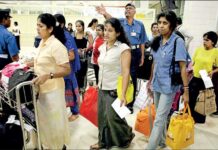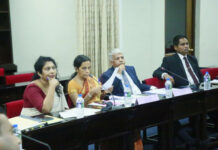Sri Lanka has requested India to expand its export quota under the Indo-Lanka Free Trade Agreement (FTA) from 8 million units to 50 million, following a crippling 44 percent tax imposed by the United States on Sri Lankan exports, Foreign Minister Vijitha Herath told Parliament on Tuesday.
“From the reciprocal tax imposed by America, there is an impact on our exports,” Minister Herath said. “We are fully utilizing the 8 million quota under the Indo-Lanka FTA. We have requested the Indian government to increase it to 50 million pieces, considering the agreement was signed 25 years ago and market demand has grown since.”
In addition, Sri Lanka has also sought facilities to boost its exports to India by USD 500 million if the quota expansion is not feasible.
The US decision, driven by President Donald Trump’s aggressive tariff strategy, applies a 44 percent tax on Sri Lankan exports based on a controversial formula that calculates duties relative to trade deficits. India, by comparison, was hit with a lower 27 percent tariff, giving it a clear edge in US-bound exports.
The sudden tax imposition, set to take effect from April 9, has already disrupted Sri Lankan export operations. Apparel industry sources revealed that US buyers have asked exporters to temporarily halt shipments in the hope of a last-minute reprieve or deadline extension.
“There are some expectations that President Trump may give an extension from the April 09 deadline,” said an apparel exporter. “If it is extended, buyers may be able to clear the goods without the tax.”
The disruption comes during a seasonal slowdown as factories pause operations for the Sinhala and Tamil New Year holidays, traditionally used for factory maintenance and extended leave.
Meanwhile, Sri Lankan officials are scheduled to meet with representatives of the Office of the US Trade Representative for South Asia to formally propose ways to reduce tariff barriers and ease the burden on local exporters.
Sri Lanka’s existing import duties—capped at 20 percent—are often compounded by additional levies such as CESS and the Port and Airport Development Levy, creating a complex and protectionist tax regime. Critics argue that these policies, particularly those targeting agricultural and consumer goods, have hurt consumers and led to nutritional deficiencies among poorer families.
Economists and trade analysts have warned that President Trump’s tariff strategy mirrors Sri Lanka’s own inward turn in recent years, notably following a controversial 25-page tax gazette issued in November 2024. That move, aimed at countering forex shortages, revived 1970s-style import substitution policies and triggered pushback from both domestic and international stakeholders.
In a previous report, the US Trade Representative highlighted concerns over Sri Lanka’s rising protectionism, noting that combined tariffs and levies could push import duties on certain goods to over 48 percent—prompting complaints from US exporters and firms operating in Sri Lanka.
As both nations grapple with the implications of rising tariffs, Sri Lanka’s move to deepen trade ties with India could provide some relief, pending favorable negotiations.



